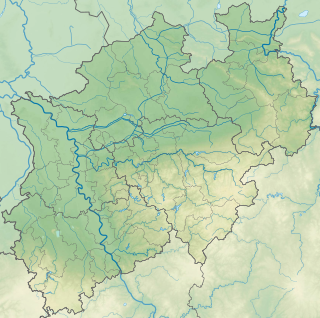Hesterthardt
| Hesterthardt | |||
|---|---|---|---|
| The Goldberg in Hagen | |||
| Systematics according to | Handbook of the natural spatial structure of Germany | ||
| Greater region 1st order | Low mountain range threshold | ||
| Greater region 2nd order | Rhenish Slate Mountains | ||
| Main unit group | 33 → Süderbergland |
||
| About main unit | 336 → West Sauerland Oberland |
||
| 4th order region (main unit) |
336 1 → Märkisches Oberland |
||
| 5th order region | 336 1 .1 → Hagen edge heights |
||
| Natural space |
336 1 .11 → Hesterthardt |
||
| Geographical location | |||
| Coordinates | 51 ° 19 '17 " N , 7 ° 22' 11.5" E | ||
|
|||
| local community | Hagen , Ennepetal , Gevelsberg | ||
| state | North Rhine-Westphalia | ||
| Country | Germany | ||
The Hesterthardt is a natural spatial unit with the ordinal number 336 1 .11 within the Hagener Randhöhen (336 1 .1) and, according to the handbook of the natural spatial structure of Germany, comprises the up to 375 m high mountain range in the Gevelsberg city forest with the elevations Hageböllinger Kopf , Mühler Kopf , Brahmskopf , Poeter Kopf and Bredder Kopf and in the Hagen city forest with the Goldberg , Riegerberg and other heights. The ridge separates the Lower Ennepetal (337 2 .0) from the Vörde-Selbecker Furche (336 1 .12) between Ennepetal - Milspe and Hagen .
The ridge is named after the Hagen district of Hestert , which is located on the slope of the otherwise largely uninhabited ridge. Hardt is a common toponym for "mountain forest", "wooded slope".
The predominantly wooded ridge rises up to 200 m above the northern Ennepe valley , runs conspicuously stretched to east-northeast and follows a deep shear flexure , which is geologically called the Ennepe jump . There lies the empty upper carbon of the Bergisch-Sauerland lowlands (over-main unit 337) against the Mühlenberg and Brandenberg layers with small remnants of mass limestone . The rock consists of sub-Middle Devonian slates and sandstones on the northern edge of the Märkisches Oberland (336 1 ). To the south, the ridge falls far less steeply about 100 m to the Vörde-Selbecker furrow. It is only broken once by the middle course of the Hasper Bach in a narrow cross valley.
The slopes of the Hesterthardt are mostly very poor in soil and have a mild climate with a May / July mean temperature of almost 15 ° C. In addition to spruce plantations, a mixed oak forest dominates , which has emerged from a previous coppice forest .

